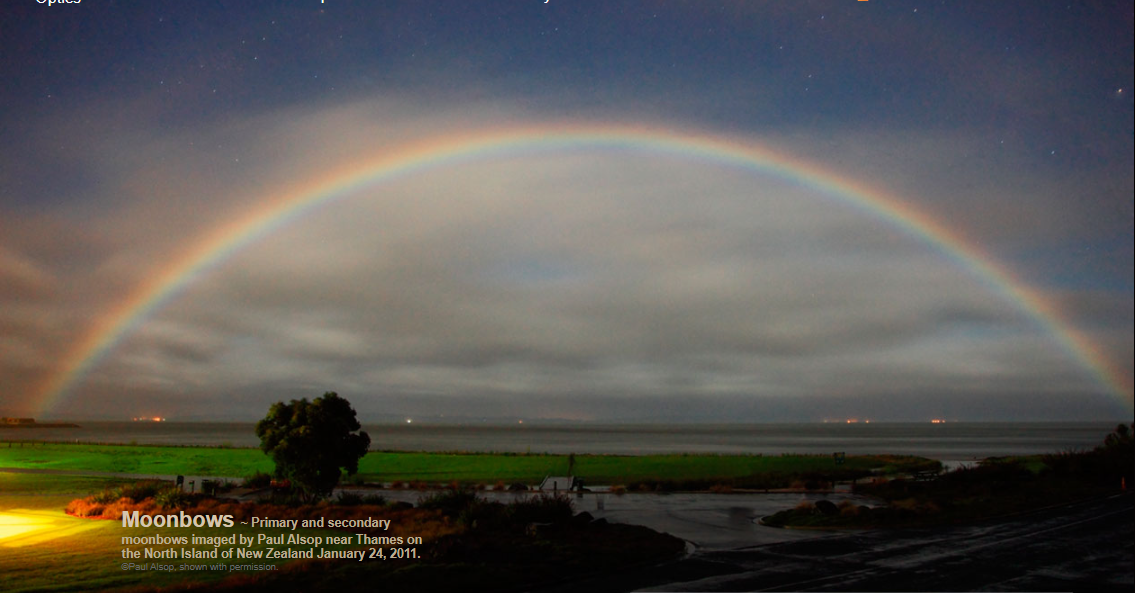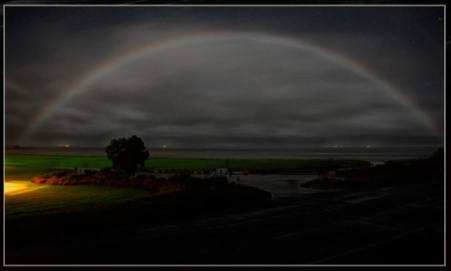OPOD - Moonbow, New Zealand
Moonbows: A Spectacular Phenomenon in New Zealand
Moonbows, also known as lunar rainbows, are a mesmerizing atmospheric optical phenomenon that occurs when moonlight is refracted and reflected by water droplets in the air. These ethereal displays of light are a rare sight, requiring specific conditions to manifest their beauty. While moonbows can be observed in various locations around the world, New Zealand has emerged as a potential addition to the list of favored places for experiencing these captivating natural wonders.
The Enchanting Encounter
Imagine a stormy night on the North Island of New Zealand. The sea roars in the darkness, inviting you to venture out for a midnight stroll. As you gaze across the Firth of Thames, you notice a faint arc in the sky, resembling a weather front. However, within minutes, this mysterious arc transforms into a radiant moonbow. Overwhelmed by its enchanting allure, you rush back home to retrieve your camera and capture this extraordinary phenomenon. And there it is, a moonbow, radiating its ethereal glow against the backdrop of a bandstand.
The Rarity of Moonbows
Moonbows are incredibly rare occurrences that require specific atmospheric conditions to manifest. To witness this celestial spectacle, one needs a bright moon positioned at an angle less than approximately 35 degrees above the horizon, a dark sky, and a rain shower opposite to the moon. The intermittent pattern of showers followed by clear skies further enhances the chances of experiencing this breathtaking phenomenon. While locations such as Hawaii, the Scottish Highlands and Isles, and Northern Ireland have been renowned for their moonbow sightings, New Zealand has recently emerged as a potential addition to this esteemed list.
The Elusive Colors of Moonbows
When captured through long-exposure photography, moonbows reveal a vibrant display of colors akin to those seen in regular rainbows. However, to the naked eye, moonbows appear ghostly and devoid of intense hues. At most, a faint hint of color may be discernible. The reason behind this discrepancy lies in the sensitivity of our eyes' color receptors in dim light. Moonbows occur during nighttime when the ambient light is considerably lower, causing the colors to appear more subdued to the unaided eye.
Moon Phases and Moonbow Challenges
Contrary to popular belief, a full moon is not a prerequisite for the formation of a moonbow. In fact, some of the most striking moonbows have been witnessed during the New Moon phase. The "Moonbow Challenge" poses an intriguing task for enthusiasts: to spot a moonbow closest to the New Moon. As of now, the record stands at an impressive 4 days and 6 hours from the occurrence of a New Moon.
Discovering Moonbows in New Zealand
New Zealand, with its diverse landscapes and unique weather patterns, offers an intriguing prospect for moonbow enthusiasts. While it may not have been traditionally regarded as a favored location for lunar and solar rainbows, recent observations suggest that New Zealand possesses the necessary ingredients for moonbow formation. The combination of a bright moon, favorable atmospheric conditions, and intermittent rain showers interspersed with clear skies creates a promising environment for experiencing these awe-inspiring spectacles.
Conclusion
Moonbows, with their ethereal charm and elusive colors, captivate the imagination of all who witness them. While they remain rare occurrences, the allure of these celestial rainbows has expanded to include potential sightings in New Zealand. As you embark on your journey to explore the natural wonders of this beautiful country, keep an eye out for stormy nights and rain showers opposite a bright moon. Who knows, you might just be lucky enough to witness the mesmerizing dance of light that is a moonbow.

Moonbows ~ Primary and secondary moonbows imaged by Paul Alsop near Thames on the North Island of New Zealand January 24, 2011. ©Paul Alsop, shown with permission.

"It was a stormy night. I went for a midnight walk to see what the sea was doing. I looked across the Firth of Thames and saw what I thought was just a weather front at first, but over a period of about 5 minutes the arc developed more into a moonbow. I ran back home to grab my camera and sure enough there is was. The light to the left is a bandstand and not a pot of gold!"
Moonbows have pots of silver at their ends.
Moonbows are rare. They need a bright moon less than ~35� high, a dark sky and a rain shower opposite. Frequent showers interspersed with clear skies help. Hawaii, the Scottish Highlands and Isles and Northern Ireland are favoured places for lunar and solar rainbows � New Zealand perhaps needs adding to the list.
Long camera exposures bring out the normal rainbow colours but to the unaided eye moonbows are ghostly objects with at most just a hint of colour (at right is an impression of the appearance). The colour receptors in our eyes are not sensitive enough in dim light.
A full moon is not needed for a moonbow. The �Moonbow Challenge�, to see a moonbow closest to New Moon, currently stands at 4 days 6 hours from new.
Note: this article has been automatically converted from the old site and may not appear as intended. You can find the original article here.
Reference Atmospheric Optics
If you use any of the definitions, information, or data presented on Atmospheric Optics, please copy the link or reference below to properly credit us as the reference source. Thank you!
-
<a href="https://atoptics.co.uk/blog/opod-moonbow-new-zealand/">OPOD - Moonbow, New Zealand</a>
-
"OPOD - Moonbow, New Zealand". Atmospheric Optics. Accessed on November 23, 2024. https://atoptics.co.uk/blog/opod-moonbow-new-zealand/.
-
"OPOD - Moonbow, New Zealand". Atmospheric Optics, https://atoptics.co.uk/blog/opod-moonbow-new-zealand/. Accessed 23 November, 2024
-
OPOD - Moonbow, New Zealand. Atmospheric Optics. Retrieved from https://atoptics.co.uk/blog/opod-moonbow-new-zealand/.